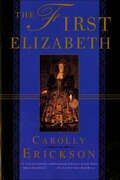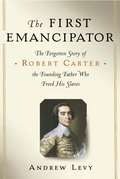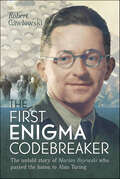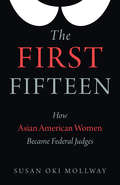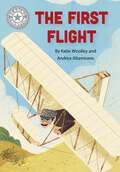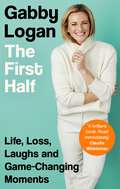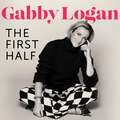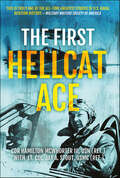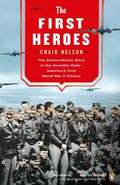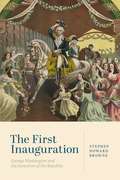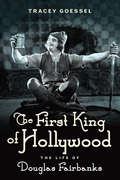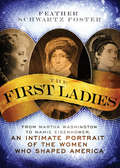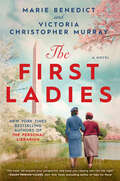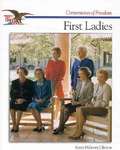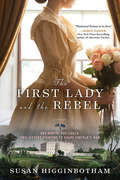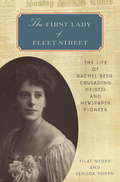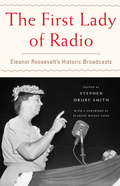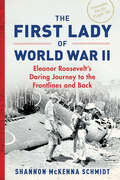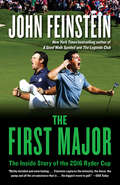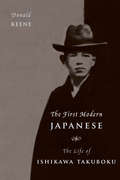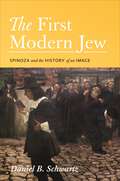- Table View
- List View
The First Elizabeth
by Carolly EricksonElizabeth I is brought to life and we see her as a living, breathing, elegant, flirtatious, diplomatic, violent, arrogant, and outrageous woman who commands our attention, fascination, and awe. The brilliant colors of Elizabethan clothing and jewelry, the texture of tapestries, and even the close, perfumed air of castle rooms are brought out openly.
The First Elizabeth
by Carolly EricksonIn this remarkable biography, Carolly Erickson brings Elizabeth I to life and allows us to see her as a living, breathing, elegant, flirtatious, diplomatic, violent, arrogant, and outrageous woman who commands our attention, fascination, and awe.With the special skill for which she is acclaimed, Carolly Erickson electrifies the senses as she evokes with total fidelity the brilliant colors of Elizabethan clothing and jewelry, the texture of tapestries, and even the close, perfumed air of castle rooms. Erickson demonstrates her extraordinary ability to discern and bring to life psychological and physical reality.
The First Emancipator: Slavery, Religion, and the Quiet Revolution of Robert Carter
by Andrew Levy"[Andrew Levy] brings a literary sensibility to the study of history, and has written a richly complex book, one that transcends Carter's story to consider larger questions of individual morality and national memory." -The New York Times Book Review. In 1791, Robert Carter III, a pillar of Virginia's Colonial aristocracy, broke with his peers by arranging the freedom of his nearly five hundred slaves. It would be the largest single act of liberation in the history of American slavery before the Emancipation Proclamation. Despite this courageous move–-or perhaps because of it-–Carter’s name has all but vanished from the annals of American history. In this haunting, brilliantly original work, Andrew Levy explores the confluence of circumstance, conviction, war, and emotion that led to Carter’s extraordinary act. As Levy points out, Carter was not the only humane master, nor the sole partisan of emancipation, in that freedom-loving age. So why did he dare to do what other visionary slave owners only dreamed of? In answering this question, Levy reveals the unspoken passions that divided Carter from others of his class, and the religious conversion that enabled him to see his black slaves in a new light. Drawing on years of painstaking research and written with grace and fire, The First Emancipator is an astonishing, challenging, and ultimately inspiring book. “A vivid narrative of the future emancipator’s evolution.” –The Washington Post Book World. “Highly recommended ... a truly remarkable story about an eccentric American hero and visionary ... should be standard reading for anyone with an interest in American history.” –Library Journal(starred review). “Absorbing... Well researched and thoroughly fascinating, this forgotten history will appeal to readers interested in the complexities of American slavery.” –Booklist(starred review)
The First Enigma Codebreaker: The Untold Story of Marian Rejewski who Passed the Baton to Alan Turing
by Robert GawlowskiThe First Enigma Codebreaker is the story of a man who started a revolution in cryptology and the conflict between man and machine. This is a powerful story of the life of Marian Rejewski and how history can affect individual lives, presented to the public for the first time. This examination of how Marian Rejewski changed the course of cryptology is of great interest to everyone from the avid historian to Hollywood film producers and all those in-between. As Gawlowski’s biography shows, Rejewski was an unassuming man who used his mathematical, skills as well as his extensive linguistic abilities, to start cracking the Enigma code before passing the baton on to the now renowned Alan Turing. This is a fascinating, human story about the man Marian Rejewski, which also ties up the loose threads of the Enigma story and shows the importance of the Polish involvement in that process. The First Enigma Codebreaker looks at those involved in cracking the Enigma and also takes a look at an aspect that has rarely been discussed in great detail, the story of Marian Rejewski himself, and how he endured life in post-war Communist Poland shining a light on situations such as how Rejewski managed to decode the machine, what happened to him during the Second World War, and the price he had to pay during the post war period.
The First Fifteen: How Asian American Women Became Federal Judges
by Susan Oki MollwayIn 1998, an Asian woman first joined the ranks of federal judges with lifetime appointments. It took ten years for the second Asian woman to be appointed. Since then, however, over a dozen more Asian women have received lifetime federal judicial appointments. This book tells the stories of the first fifteen. In the process, it recounts remarkable tales of Asian women overcoming adversity and achieving the American dream, despite being the daughters of a Chinese garment worker, Japanese Americans held in internment camps during World War II, Vietnamese refugees, and penniless Indian immigrants. Yet The First Fifteen also explores how far Asian Americans and women still have to go before the federal judiciary reflects America as a whole. In a candid series of interviews, these judges reflect upon the personal and professional experiences that led them to this distinguished position, as well as the nerve-wracking political process of being nominated and confirmed for an Article III judgeship. By sharing their diverse stories, The First Fifteen paints a nuanced portrait of how Asian American women are beginning to have a voice in determining American justice.
The First Flight: Independent Reading White 10 (Reading Champion #1717)
by Katie WoolleyThis story is part of Reading Champion, a series carefully linked to book bands to encourage independent reading skills, developed with Dr Sue Bodman and Glen Franklin of UCL Institute of Education (IOE) Fantastic, original stories are accompanied by engaging artwork and a reading activity. Each book has been carefully graded so that it can be matched to a child's reading ability, encouraging reading for pleasure. Perfect for 5-7 year olds or those reading book band white.
The First Half
by Gabby LoganA brilliant book. Read immediately' Claudia WinklemanA fascinating, inspiring and funny memoir from much-loved broadcaster Gabby Logan When I sat down to write this book, I was really not keen on the idea of writing a biography that charted my life in a regular, linear fashion. Largely because I thought that nobody would be interested in how well I did in my maths GCSE ( C ) or what my first dog was called (Sadie). But looking back over my life I realise we are all a product of the things that happen to us along the way, even the most fleeting of conversations with a stranger, and by gathering my turning points and life-changing moments together, I have found a way of telling the story of my life - a story of family, love, loss, determination, devastating lows and the highest of highs. Whether it's presenting the Olympics, dancing on Strictly or chatting to guests on her hugely popular podcast, Gabby Logan has been a much-loved broadcaster and a fixture in our lives for over 25 years. In this, her first ever book, Gabby takes us through the story of her life through the turning points and important events that have led her to where she is today. Just how did the little girl who lay in bed pondering the big questions like Why do I matter? Why was I born? end up as a woman who dropped her physics GCSE at the first chance and now talks on telly for a living? Gabby talks candidly about the highs, lows, loves and losses she's experienced. Whether it's the heart-breaking early death of her brother, her father's alcoholism, navigating sexism at work or the time she almost became the Rose of Tralee by accident, The First Half is an entertaining, absorbing, inspirational memoir which will make you laugh and cry.
The First Half
by Gabby LoganA brilliant book. Read immediately' Claudia WinklemanA fascinating, inspiring and funny memoir from much-loved broadcaster Gabby Logan When I sat down to write this book, I was really not keen on the idea of writing a biography that charted my life in a regular, linear fashion. Largely because I thought that nobody would be interested in how well I did in my maths GCSE ( C ) or what my first dog was called (Sadie). But looking back over my life I realise we are all a product of the things that happen to us along the way, even the most fleeting of conversations with a stranger, and by gathering my turning points and life-changing moments together, I have found a way of telling the story of my life - a story of family, love, loss, determination, devastating lows and the highest of highs. Whether it's presenting the Olympics, dancing on Strictly or chatting to guests on her hugely popular podcast, Gabby Logan has been a much-loved broadcaster and a fixture in our lives for over 25 years. In this, her first ever book, Gabby takes us through the story of her life through the turning points and important events that have led her to where she is today. Just how did the little girl who lay in bed pondering the big questions like Why do I matter? Why was I born? end up as a woman who dropped her physics GCSE at the first chance and now talks on telly for a living? Gabby talks candidly about the highs, lows, loves and losses she's experienced. Whether it's the heart-breaking early death of her brother, her father's alcoholism, navigating sexism at work or the time she almost became the Rose of Tralee by accident, The First Half is an entertaining, absorbing, inspirational memoir which will make you laugh and cry.'A lovely read for women who love to read about inspiring women' - Lorraine Candy
The First Hellcat Ace
by Jay A. Stout Hamilton McWhorter"This memoir is a tribute to the author's service in World War II. It is a realistic look at the life of a carrier pilot, eschewing any attempt at glory-seeking, instead delving into their concerns, duties and hardships." — WWII History Magazine Although he objected to being characterized as such, Hamilton McWhorter III's service to family and country make him a standout among America's Greatest Generation. A Georgia native whose family roots date from that region's settlement during the 1700s, “Mac” McWhorter was a naval aviation cadet undergoing training when Pearl Harbor was attacked by Japan on December 7, 1941. After earning his Wings of Gold in early 1942, Ensign McWhorter was trained as a fighter pilot in the robust but technologically outmoded F4F Wildcat. Initially assigned to VF-9—a fiercely spirited and hard-playing fighter squadron—he saw first combat in November 1942 against Vichy French forces in North Africa. After returning to the United States, VF-9 became the first unit to convert to the new Grumman F6F Hellcat. This was the fighter the U.S. Navy would use to crush Japanese air power during the long offensive from the Southwest Pacific to the shores of Japan. From mid-1943, Hamilton McWhorter was constantly engaged in the unforgiving and deadly aerial warfare that characterized the battles against Imperial Japan. His fifth aerial victory, in November 1943 off Tarawa Atoll, made him the first ace in the Hellcat, and seven subsequent victories ensured his place in the annals of air-to-air combat. McWhorter's combat service, from the beginning of the war to the last campaign off the shores of Okinawa, makes his story a must-read for the serious student of the Pacific air war. Hamilton McWhorter III retired from the Navy as a commander in 1969. He passed away in 2008.
The First Heroes
by Craig Nelson18 April 1942. Sixteen planes take off from a US Navy carrier in the mid-Pacific. A squadron of young, barely trained flyers under a famous daredevil, Jimmy Doolittle, they are America's first retaliation towards Japan since Pearl Harbor. Their mission: to bomb Japan's 's five main cities including Tokyo. Critically compromised by the discovery of the US fleet by Japanese spies, they are not expected to come back. Having successfully delivered their bombs, most of the squadron run out of fuel and are forced to crash land in Japan, China and the Soviet Union. The stories of their journeys home are as heroic as that of the raid itself. Incredibly of the 80 flyers who left the USS . . . 90% eventually returned alive to the US. The First Heroes tells the extraordinary story of the daring raid and shows for the first time the real story of what was to be the turning point in the war against Japan.
The First Inauguration: George Washington and the Invention of the Republic
by Stephen Howard Browne"Among the vicissitudes incident to life, no event could have filled me with greater anxieties than that of which the notification was transmitted by your order, and received on the fourteenth day of the present month." With these words to the assembled members of the Senate and House of Representatives on April 30, 1789, George Washington inaugurated the American experiment. It was a momentous occasion and an immensely important moment for the nation. Never before had a people dared to invent a system of government quite like the one that Washington was preparing to lead, and the tensions between hope and skepticism ran high.In this book, distinguished scholar of early America Stephen Howard Browne chronicles the efforts of the first president of the United States of America to unite the nation through ceremony, celebrations, and oratory. The story follows Washington on his journey from Mount Vernon to the site of the inauguration in Manhattan, recounting the festivities—speeches, parades, dances, music, food, and flag-waving—that greeted the president-elect along the way. Considering the persuasive power of this procession, Browne captures in detail the pageantry, anxiety, and spirit of the nation to arrive at a more nuanced and richly textured perspective on what it took to launch the modern republican state. Compellingly written and artfully argued, The First Inauguration tells the story of the early republic—and of a president who, by his words and comportment, provides a model of leadership and democratic governance for today.
The First Inauguration: George Washington and the Invention of the Republic
by Stephen Howard Browne“Among the vicissitudes incident to life, no event could have filled me with greater anxieties than that of which the notification was transmitted by your order, and received on the fourteenth day of the present month.”With these words to the assembled members of the Senate and House of Representatives on April 30, 1789, George Washington inaugurated the American experiment. It was a momentous occasion and an immensely important moment for the nation. Never before had a people dared to invent a system of government quite like the one that Washington was preparing to lead, and the tensions between hope and skepticism ran high.In this book, distinguished scholar of early America Stephen Howard Browne chronicles the efforts of the first president of the United States of America to unite the nation through ceremony, celebrations, and oratory. The story follows Washington on his journey from Mount Vernon to the site of the inauguration in Manhattan, recounting the festivities—speeches, parades, dances, music, food, and flag-waving—that greeted the president-elect along the way. Considering the persuasive power of this procession, Browne captures in detail the pageantry, anxiety, and spirit of the nation to arrive at a more nuanced and richly textured perspective on what it took to launch the modern republican state. Compellingly written and artfully argued, The First Inauguration tells the story of the early republic—and of a president who, by his words and comportment, provides a model of leadership and democratic governance for today.
The First Jet Pilot: The Story of German Test Pilot Erich Warsitz
by Lutz WarsitzOn 27 August 1939, Flugkapitan Erich Warsitz became the first man to fly a jet aircraft, the Heinkel He 178 and in June of the same year he flew the first liquid-fuel rocket aircraft, the Heinkel He 176. His legendary flying skills enabled him to assist the pioneering German aircraft and engine design teams that included Wernher von Braun and Ernst Heinkel. He repeatedly risked his life extending the frontiers of aviation in speed, altitude and technology and survived many life-threatening incidents.This book is written by Erichs son who has used his fathers copious notes and log books that explain vividly the then halcyon days of German aviation history. Warsitz was feted by the Reichs senior military figures such as Milch, Udet and Lucht and even Hitler keenly followed his experimental flying. Little is known of this pioneer period because of the strict secrecy which shrouded the whole project it is a fascinating story that tells of the birth of the jet age and flight as we know it today. The book includes many unseen photographs and diagrams.
The First King of Hollywood: The Life of Douglas Fairbanks
by Tracey GoesselThe complete, definitive biography of Hollywood's first superstar Douglas Fairbanks was the greatest leading man of his generation--the first and the best of the swashbucklers. He made some of the greatest films of the silent era, including The Thief of Bagdad, Robin Hood, and The Mark of Zorro. With Charlie Chaplin, D. W. Griffith, and his wife, film star Mary Pickford, he founded United Artists. Pickford and Fairbanks ruled Hollywood as its first king and queen for a decade. Now a cache of newly discovered love letters from Fairbanks to Pickford form the centerpiece of the first truly definitive biography of Hollywood's first king, the original Robin Hood, the true Zorro, the man who did his own stunts, built his own studio, and formed a company that allowed artists to distribute their own wealth outside the studio system. Fairbanks was fun, witty, engaging, creative, athletic, and a force to be reckoned with. He shaped our idea of the Hollywood hero, and it has never been the same since. His story, like his movies, is full of passion, bravado, and romance.
The First Ladies
by Feather Schwartz FosterAs a young nation grew into its own, it was not just the presidents who led the way. The remarkable women of the White House, often neglected by history, had a heavy hand in the shaping of America. The earliest First Ladies of the United States left countless untold legacies behind after their role at the White House was over. Decidedly different from their modern day counterparts, the nation's first presidential wives made their impact not in terms of political policy or broad social and civic service, but instead with unique, personal, and often long-lasting accomplishments.
The First Ladies
by Marie Benedict Victoria Christopher MurrayThe Instant New York Times Bestseller! A novel about the extraordinary partnership between First Lady Eleanor Roosevelt and civil rights activist Mary McLeod Bethune—an unlikely friendship that changed the world, from the New York Times bestselling authors of the Good Morning America Book Club pick The Personal Librarian. The daughter of formerly enslaved parents, Mary McLeod Bethune refuses to back down as white supremacists attempt to thwart her work. She marches on as an activist and an educator, and as her reputation grows she becomes a celebrity, revered by titans of business and recognized by U.S. Presidents. Eleanor Roosevelt herself is awestruck and eager to make her acquaintance. Initially drawn together because of their shared belief in women&’s rights and the power of education, Mary and Eleanor become fast friends confiding their secrets, hopes and dreams—and holding each other&’s hands through tragedy and triumph. When Franklin Delano Roosevelt is elected president, the two women begin to collaborate more closely, particularly as Eleanor moves toward her own agenda separate from FDR, a consequence of the devastating discovery of her husband&’s secret love affair. Eleanor becomes a controversial First Lady for her outspokenness, particularly on civil rights. And when she receives threats because of her strong ties to Mary, it only fuels the women&’s desire to fight together for justice and equality. This is the story of two different, yet equally formidable, passionate, and committed women, and the way in which their singular friendship helped form the foundation for the modern civil rights movement.
The First Ladies (Cornerstones of Freedom)
by Susan ClintonThe First Lady--the wife of the president of the United States--has one of the most interesting positions in American public life. The First Lady is not elected, yet she can have great influence and power. She is the ultimate insider, yet she must be very careful about saying what she thinks.
The First Lady and the Rebel: A Novel
by Susan HigginbothamFrom celebrated author Susan Higginbotham comes an incredible book about Abraham Lincoln's First Lady and, on the other side of the Civil War, her sister.A Union's First LadyAs the Civil War cracks the country in two, Mary Lincoln stands beside her husband praying for a swift Northern victory. But as the body count rises, Mary can't help but fear each bloody gain. Because her beloved sister Emily is across party lines, fighting for the South, and Mary is at risk of losing both her country and her family in the tides of a brutal war.A Confederate Rebel's WifeEmily Todd Helm has married the love of her life. But when her husband's southern ties pull them into a war neither want to join, she must make a choice. Abandon the family she has built in the South or become a true rebel woman fighting against the sister she has always loved best.With a country's legacy at stake, how will two sisters shape history?A Civil War book about two women determined to do the right thing, The First Lady and the Rebel is sure to inspire fans of Marie Benedict and Stephanie Dray.
The First Lady of Fleet Street
by Yehuda Koren Eilat NegevA panoramic portrait of a remarkable woman and the tumultuous Victorian era on which she made her mark, The First Lady of Fleet Street chronicles the meteoric rise and tragic fall of Rachel Beer--indomitable heiress, social crusader, and newspaper pioneer.Rich with period detail and drawing on a wealth of original material, this sweeping work of never-before-told history recounts the ascent of two of London's most prominent Jewish immigrant families--the Sassoons and the Beers. Born into one, Rachel married into the other, wedding newspaper proprietor Frederick Beer, the sole heir to his father's enormous fortune. Though she and Frederick became leading London socialites, Rachel was ambitious and unwilling to settle for a comfortable, idle life. She used her husband's platform to assume the editorship of not one but two venerable Sunday newspapers--the Sunday Times and The Observer--a stunning accomplishment at a time when women were denied the vote and allowed little access to education. Ninety years would pass before another woman would take the helm of a major newspaper on either side of the Atlantic.It was an exhilarating period in London's history--fortunes were being amassed (and squandered), masterpieces were being created, and new technologies were revolutionizing daily life. But with scant access to politicians and press circles, most female journalists were restricted to issuing fashion reports and dispatches from the social whirl. Rachel refused to limit herself or her beliefs. In the pages of her newspapers, she opined on Whitehall politics and British imperial adventures abroad, campaigned for women's causes, and doggedly pursued the evidence that would exonerate an unjustly accused French military officer in the so-called Dreyfus Affair. But even as she successfully blazed a trail in her professional life, Rachel's personal travails were the stuff of tragedy. Her marriage to Frederick drove an insurmountable wedge between herself and her conservative family. Ultimately, she was forced to retreat from public life entirely, living out the rest of her days in stately isolation.While the men of her era may have grabbed more headlines, Rachel Beer remains a pivotal figure in the annals of journalism--and the long march toward equality between the sexes. With The First Lady of Fleet Street, she finally gets the front page treatment she deserves.
The First Lady of Radio
by Blanche Wiesen Cook Stephen Drury SmithOn the afternoon of December 7, 1941, as a stunned nation gathered around the radio to hear the latest about Pearl Harbor, Eleanor Roosevelt was preparing for her weekly Sunday evening national radio program. At 6:45pm, listeners to the NBC Blue network heard the First Lady's calm, measured voice explain that the president was conferring with his top advisors to address the crisis. It was a remarkable broadcast. With America on the verge of war, the nation heard first not from their president, but from his wife.Eleanor Roosevelt's groundbreaking career as a professional radio broadcaster is almost entirely forgotten. As First Lady, she hosted a series of prime time programs that revolutionized how Americans related to their chief executive and his family. Now, The First Lady of Radio rescues these broadcasts from the archives, presenting a carefully curated sampling of transcripts of Roosevelt's most famous and influential radio shows, edited and set into context by award-winning author and radio producer Stephen Drury Smith. With a foreword by Roosevelt's famed biographer, historian Blanche Wiesen Cook, The First Lady of Radio is both a historical treasure and a fascinating window onto the power and the influence of a pioneering First Lady.
The First Lady of World War II: Eleanor Roosevelt's Daring Journey to the Frontlines and Back
by Shannon McKenna SchmidtThe first book to tell the full story of Eleanor Roosevelt's unprecedented and courageous trip to the Pacific Theater during World War II.On August 27, 1943, news broke in the United States that First Lady Eleanor Roosevelt was on the other side of the world. A closely guarded secret, she had left San Francisco aboard a military transport plane headed for the South Pacific to support and report the troops on WW2's front lines. Americans had believed she was secluded at home.As Allied forces battled the Japanese for control of the region, Eleanor was there on the frontlines, spending five weeks traveling, on a mission as First Lady of the United States to experience what our servicemen were experiencing... and report back home."The most remarkable journey any president's wife has ever made."—Washington Times-Herald, September 28, 1943"Mrs. Roosevelt's sudden appearance in New Zealand well deserves the attention it is receiving. This is the farthest and most unexpected junket of a First Lady whose love of getting about is legendary."—Detroit Free Press, August 28, 1943"By a happy chance for Australia, this famous lady's taste for getting about, her habit of seeing for herself what is going on in the world, and, most of all, her deep concern for the welfare of the fighting men of her beloved country, have brought her on the longest journey of them all—across the wide, war-clouded Pacific."—Sydney Morning Herald, September 4, 1943"No other U.S. mother had seen so much of the panorama of the war, had been closer to the sweat and boredom, the suffering."—Time, October 4, 1943
The First Major: The Inside Story of the 2016 Ryder Cup
by John FeinsteinFrom the #1 New York Times bestselling author of A Good Walk Spoiled, a dramatic chronicle of the bitterly-fought 2016 Ryder Cup pitting a U.S. team out for revenge against the Europeans determined to keep the Cup out of American hands.Coming into 2016, the Americans had lost an astounding six out of the last seven Ryder Cup matches, and tensions were running high for the showdown that took place in October, 2016 in Hazeltine, Minnesota, just days after American legend Arnold Palmer had died. What resulted was one of the most raucous and heated three days in the Cup's long history. Award-winning author John Feinstein takes readers behind the scenes, providing an inside view of the dramatic stories as they unfolded: veteran Phil Mickelson's two-year roller-coaster as he upended the American preparation process and helped assemble a superb team; superstar Rory McIlroy becoming the clear-cut emotional leader of the European team, and his reasons for wanting to beat the US team so badly this time around; the raucous matches between McIlroy and American Patrick Reed - resulting in both incredible golf, and several moments that threatened to come to blows; the return of Tiger Woods not as a player but an assistant captain, and his obsession with helping the US win - which was never the case when he was playing. John Feinstein's classic bestseller, A Good Walk Spoiled, set the bar for golf books. Now Feinstein provides his unique take on the Ryder Cup, which has clearly become golf's most intense and emotional event...it's 'first Major.'
The First Modern Japanese: The Life of Ishikawa Takuboku
by Donald KeeneThousands of books and monographs have been devoted to the poet and critic Ishikawa Takuboku (1886-1912). Although he died at the age of twenty-six and wrote many of his best-known poems in the space of a few years, his name is familiar to every literate Japanese. His early death added to the sad romance of the unhappy poet, but there has been no satisfactory biography of his life or career, even in Japanese, and only a small part of his writings have been translated. His mature poetry was based on the work of no predecessor, and he left no disciples. He stands unique.Takuboku's most popular poems, especially those with a humorous overlay, are well read and memorized, but his diaries and letters, though less familiar, contain rich and vivid glimpses of the poet's thoughts and experiences. They reflect the outlook of an unconstrained man who at times behaved in a startling or even shocking manner. Despite his misdemeanors, Takuboku is regarded as a national poet, all but a saint to his admirers, especially in the regions of Japan where he lived. His refusal to conform to the Japan of the time drove him in striking directions and ranked him as the first poet of the new Japan.
The First Modern Japanese: The Life of Ishikawa Takuboku (Asia Perspectives: History, Society, and Culture)
by Donald KeeneMany books in Japanese have been devoted to the poet and critic Ishikawa Takuboku (1886–1912). Although he died at the age of twenty-six and wrote many of his best-known poems in the space of a few years, his name is familiar to every literate Japanese. Takuboku's early death added to the sad romance of the unhappy poet, but there has been no satisfactory biography of his life or career, even in Japanese, and only a small part of his writings have been translated. His mature poetry was based on the work of no predecessor, and he left no disciples. Takuboku stands unique.Takuboku's most popular poems, especially those with a humorous overlay, are often read and memorized, but his diaries and letters, though less familiar, contain rich and vivid glimpses of the poet's thoughts and experiences. They reflect the outlook of an unconstrained man who at times behaved in a startling or even shocking manner. Despite his misdemeanors, Takuboku is regarded as a national poet, all but a saint to his admirers, especially in the regions of Japan where he lived. His refusal to conform to the Japan of the time drove him in striking directions and ranked him as the first poet of the new Japan.
The First Modern Jew: Spinoza and the History of an Image
by Daniel B. SchwartzPioneering biblical critic, theorist of democracy, and legendary conflater of God and nature, Jewish philosopher Baruch Spinoza (1632-1677) was excommunicated by the Sephardic Jews of Amsterdam in 1656 for his "horrible heresies" and "monstrous deeds." Yet, over the past three centuries, Spinoza's rupture with traditional Jewish beliefs and practices has elevated him to a prominent place in genealogies of Jewish modernity. The First Modern Jew provides a riveting look at how Spinoza went from being one of Judaism's most notorious outcasts to one of its most celebrated, if still highly controversial, cultural icons, and a powerful and protean symbol of the first modern secular Jew. Ranging from Amsterdam to Palestine and back again to Europe, the book chronicles Spinoza's posthumous odyssey from marginalized heretic to hero, the exemplar of a whole host of Jewish identities, including cosmopolitan, nationalist, reformist, and rejectionist. Daniel Schwartz shows that in fashioning Spinoza into "the first modern Jew," generations of Jewish intellectuals--German liberals, East European maskilim, secular Zionists, and Yiddishists--have projected their own dilemmas of identity onto him, reshaping the Amsterdam thinker in their own image. The many afterlives of Spinoza are a kind of looking glass into the struggles of Jewish writers over where to draw the boundaries of Jewishness and whether a secular Jewish identity is indeed possible. Cumulatively, these afterlives offer a kaleidoscopic view of modern Jewish cultureand a vivid history of an obsession with Spinoza that continues to this day.

